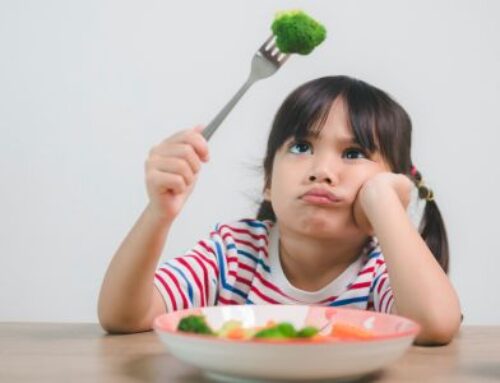
Feeding kids is hard work. Before we get into the details of feeding your little people, let’s leave the confusion of which food is and isn’t “healthy” to the side for the time being. Because as you would know, just getting them to eat in the first place is enough of a challenge.
Do you find yourself limited in what you can serve for dinner because your toddler launches into a tantrum if certain foods make their way on to the table? Can you count the number of different foods your 4 year old will eat on one hand?
You are not alone! Fussy eating is common, and indeed a part of normal childhood development. Just because it’s normal doesn’t mean we shouldn’t take action – this article explains why it is important to address fussy eating.
Every child displays fussy eating tendencies at some time or another. It’s how we, as caregiver’s, handle meal and snack times that determines whether or not these tendencies impact on their food intake. When we let our children’s food preferences dictate what meals we prepare then we’re setting ourselves up for a long battle with fussy eating. And once they realise you’re catering to their preferences (and it doesn’t take them long to realise this), they start to narrow down the list of accepted foods until they just get to eat their favourite foods all day long. To prevent yourself heading down that path, there are some handy tips for tackling meal times.
When it comes to food and eating, it’s important to remind ourselves who is responsible for what. This is best explained using Ellyn Satter’s Division of Responsibility:
Adults decide: What to eat. When to eat. Where to eat
Children decide: How much to eat.
Under the Division of Responsibility, children have it pretty easy. Their responsibility is they decide how much to eat. That’s it. Simple, right?
As care givers, our list of responsibilities is slightly longer. We decide what food is offered, when food is offered, and where the food is offered – essentially the WHAT, WHEN and WHERE of meal times.
You’re probably thinking to yourself that you already have responsibility of all three of these, but think about it. If you don’t cook broccoli because you don’t want a tantrum then you are no longer responsible for the WHAT – your child is. As I mentioned above, that’s not their responsibility. They just decide how much of the broccoli is eaten, not whether or not it’s served. If your kindergartener is helping himself to all the snack foods in the cupboard after school but then isn’t interested in dinner, he’s taken over the responsibility of WHEN. And if your toddler refuses to sit at the table for lunch and just grabs random pieces of food as she runs past, you’ve also handed over your responsibility of WHERE.
Over this series of fussy eating articles I’ll be covering the WHAT, WHEN and WHERE in more detail. These articles will help you take back these responsibilities, and thereby tackle your child’s fussy eating tendencies.
If you’re struggling with the WHAT and don’t know where to start, here is an example of a healthy day of food for kids.
Try some of these snacks as a starting point:
Fruit and Vegetable Tasting Plate

Check out our post on How to Make a Fruit and Vegetable Tasting Plate for more information.
Yoghurt and Muesli Parfait

Very active kids who engage in lots of sport will benefit from this snack. Why not try making them a Yoghurt Parfait with layers of fresh fruit
Trail Mix

This snack will give you sweetness combined with some healthy fats and fibre to help you feel satisfied and content. Here are some trail mix combinations you can try.
If your children seem to have an endless appetite for snacks and you’re struggling to keep on top of healthy food options this article will help.
Being consistent with the WHERE and WHEN can be really hard. The 3 P’s of Healthy Kids and Toddlers are essential to implementing these things
Here are some more simple tips to get fussy toddlers to eat healthy food
Michelle Saunders is our Paediatric Dietitian expert and can help you with a fussy eater.



